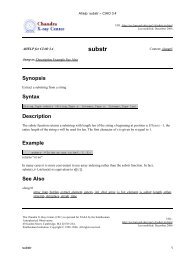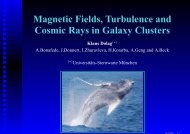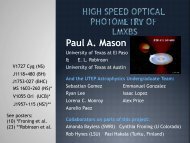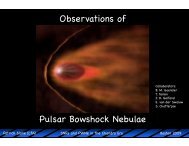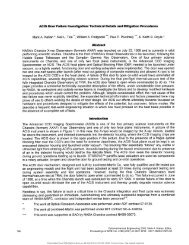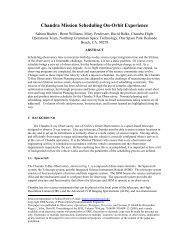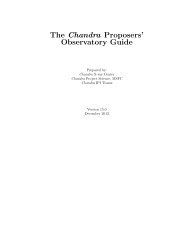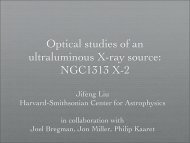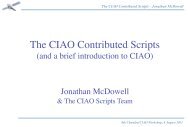PDF Version - Chandra X-Ray Observatory (CXC)
PDF Version - Chandra X-Ray Observatory (CXC)
PDF Version - Chandra X-Ray Observatory (CXC)
You also want an ePaper? Increase the reach of your titles
YUMPU automatically turns print PDFs into web optimized ePapers that Google loves.
Spring, 2012<br />
Time (Ms)<br />
160<br />
140<br />
120<br />
100<br />
80<br />
60<br />
40<br />
20<br />
0<br />
Time per Cycle<br />
1 2 3 4 5 6 7 8 9 10 11 12 13<br />
Cycle<br />
Time Requested<br />
Time Awarded<br />
Fig. 2: The requested and approved time as a function of cycle in Msecs. This<br />
increased in the first few cycles, the largest effect being due to the introduction<br />
of Very Large Projects (VLPs) in Cycle 5. The increase in requested and awarded<br />
time in Cycle 13 is clear.<br />
BPP panelists updated review reports, as needed, at the review<br />
and remotely over the following 2 weeks. The schedule<br />
for the BPP at the review included time for reading and for<br />
meeting with appropriate panel members to allow coordination<br />
for each subject area. The BPP meeting extended<br />
into Friday afternoon to allow for additional discussion and<br />
a consensus on the final rank-ordered lists to be reached.<br />
The resulting observing and research program for<br />
Cycle 13 was posted on the <strong>CXC</strong> website on 15 July 2011,<br />
following detailed checks by <strong>CXC</strong> staff and approval by the<br />
Selection Official (<strong>CXC</strong> Director). All peer review reports<br />
were reviewed by <strong>CXC</strong> staff for clarity and consistency with<br />
the recommended target list. Formal e-letters informing<br />
the PIs of the results, budget information (when appropriate)<br />
and providing a report from the peer review, were e-<br />
Fig. 3: The final oversubscription<br />
in observing<br />
time based on requested<br />
and allocated<br />
time in each cycle. Again<br />
the numbers are remarkably<br />
constant. The decrease<br />
in Cycle 12 reflects<br />
the 16% larger amount<br />
of time awarded by the<br />
peer review in that cycle<br />
to offset the significantly<br />
increasing observing<br />
efficiency as the orbit<br />
evolved (see article in<br />
2011 Newsletter).<br />
Oversubscription Ratio<br />
8<br />
7<br />
6<br />
5<br />
4<br />
3<br />
2<br />
1<br />
0<br />
Total Oversubscription in Time<br />
mailed to each PI in early August.<br />
1 2 3 4 5 6 7 8 9 10 11 12 13<br />
Cycle<br />
Joint Time Allocation<br />
Constrained Observations<br />
23<br />
<strong>Chandra</strong> time was also allocated to<br />
several joint programs by the proposal review<br />
processes of XMM-Newton (4 proposals)<br />
and Spitzer (2 proposals).<br />
The <strong>Chandra</strong> review accepted joint<br />
proposals with time allocated on: Hubble<br />
(20), XMM-Newton (4), NRAO (12), and<br />
NOAO (2).<br />
As observers are aware, the biggest<br />
challenge to efficient scheduling of <strong>Chandra</strong><br />
observations is in regulating the temperature<br />
of the various satellite components (see<br />
POG Section 3.3.3). In Cycle 9 we instituted<br />
a classification scheme for constrained ob-<br />
servations which accounts for the difficulty<br />
of scheduling a given observation (CfP Section 5.2.8). Each<br />
constraint class was allocated an annual quota based on<br />
our experience in previous cycles. The same classification<br />
scheme was used in Cycles 10–13. In Cycle 13, the quotas<br />
were increased commensurate with the larger amount of<br />
observing time to be awarded. There was a large demand<br />
for constrained time so that not all proposals which requested<br />
time-constrained observations and had a passing<br />
rank (>3.5) could be approved. Effort was made to ensure<br />
that the limited number of constrained observations were<br />
allocated to the highest-ranked proposals review-wide. Detailed<br />
discussions with panel chairs enabled us to record the<br />
priorities of their panels in the event that more constrained<br />
observations could be allocated. Any remaining uncertainty<br />
concerning priorities during the final decision process



